
Flying Officer Nirmal Jit Singh Sekhon, PVC was an officer of the Indian Air Force. He was posthumously awarded the Param Vir Chakra, India's highest military decoration during war time, in recognition of his lone defence of Srinagar Air Base against a Pakistan Air Force (PAF) air raid during the Indo-Pakistani War of 1971. He is the only member of the Indian Air Force to be honoured with the PVC.

Sarfaraz Ahmed Rafiqui was a Pakistani fighter pilot. He is best known for his gallant actions in two of the aerial dogfights during the Indo-Pakistani War of 1965, and is a recipient of both the Hilal-e-Jurat and the Sitara-e-Jurat military awards from the Government of Pakistan. He is considered as one of the most decorated officers of the Pakistan Air Force as he had the honour to be awarded with the second and third highest gallantry award.
The No. 3 Squadron IAF (Cobras) of the Indian Air Force (IAF) operates as a Close Air Support (CAS) and reconnaissance unit. Currently based at NAL Air Force Station, it falls under the Western Air Command, and forms the 46 wing of the IAF.
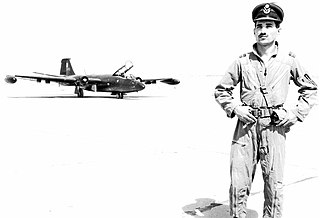
Najeeb Ahmad Khan, commonly known as 8-Pass Charlie, was a Pakistani bomber pilot who raided the Adampur Airbase in India a number of times during the Indo-Pakistani War of 1965, notably starting a series of airstrikes on the base by a solo raid.
Sitara-e-Jurat is the third highest military award of Pakistan. It was established in 1957 after Pakistan became a republic; however, it was instituted retrospectively back to 1947. It is awarded for gallantry or distinguished service in combat; and can be bestowed upon officers, junior commissioned officers, petty officers, warrant officers, soldiers, sailors, airmen, and equivalents in the Pakistan Army, Navy, Air Force, and various paramilitary forces under federal control, such as the Frontier Corps, the Frontier Constabulary, and the Pakistan Rangers. It may be considered to be roughly equivalent to the Military Cross and the Silver Star.

During the Indo-Pakistani war of 1965, the Indian and Pakistani Air Forces engaged in large-scale aerial combat for the first time. In the air war, which took place in September, both air forces conducted thousands of defensive and offensive sorties over Indian and Pakistani airspace. Both India and Pakistan claimed victory in the air war; Pakistan claimed to have destroyed 104 Indian aircraft and lost 19, and India claimed to have destroyed 73 Pakistani aircraft and lost 35 of its own. The air war ended in a stalemate.

Mohammed Azim Daudpota was a three-star officer in the Pakistan Air Force who went on to serve as the Chief of Air Staff of Air Force of Zimbabwe, and then to briefly serve as Governor of Sindh.
Rao Qamar SulemanNI(M) HI(M) SI(M) SBt TI(M) LoM was the 12th Chief of Air Staff of the Pakistan Air Force. The four-star ranked general commanded the PAF from 2009 to 2012. Earlier, Suleman served as Deputy Chief of Air Staff of Operations. He was succeeded by Air Chief Marshal Tahir Rafique Butt as Chief of Air Staff on 7 March 2012.
Abdus Sattar Alvi, SJ, SI(M), is a retired one-star rank air officer and a fighter pilot in the Pakistan Air Force, who is renowned for his gallant actions during the third Indo-Pakistani in 1971, and served as a military advisor in the Syrian Air Force during the Yom Kippur War of 1973.
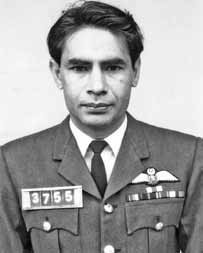
Syed Manzoor ul Hassan Hashmi was squadron leader in the Pakistan Air Force. He served in the 1965 and 1971 wars. He was a recipient of the Sitara-e-Jurat.

Muhammad Mahmood AlamSJ & Bar SI(M), popularly known as M. M. Alam, was a Pakistani fighter pilot and war hero, officially credited by the Pakistan Air Force with having downed five Indian fighter aircraft in under a minute and establishing a world record during the 1965 Indo-Pakistani War.

No. 11 Squadron, named the Arrows, is a Pakistan Air Force (PAF) fighter squadron assigned to the No. 39 Multi-Role Wing of the PAF Southern Air Command. It operates the Block 15 MLU model of the F-16 Fighting Falcon with a multi-role tasking and is also an Operational Conversion Unit (OCU).
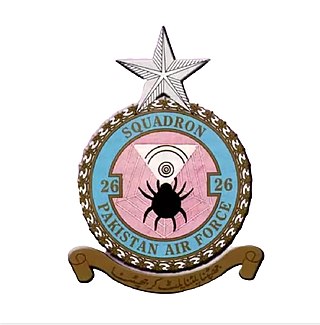
The No. 26 Squadron, nicknamed the Black Spiders, is a multi-role squadron of the Pakistan Air Force's Northern Air Command. It is currently based at Peshawar Airbase and operates the PAC JF-17 Thunder multirole fighter jets.

Saiful Azam (Bengali: সাইফুল আজম; was a Bangladeshi fighter pilot, ace, and politician who first served as a fighter pilot for the Pakistan Air Force and later the Bangladesh Air Force. According to Pakistani sources, during his career as PAF pilot, he shot down one Indian Air Force and four Israel Air Force aircraft. For his actions, he received various gallantry awards from Pakistan, Jordan and Iraq. He also took part in 12 ground-attack missions against the Indian forces. After the liberation of Bangladesh, he joined the newly formed Bangladesh Air Force.
Squadron Leader Mandepanda Appachu Ganapathy was a fighter pilot and officer of the Indian Air Force, known for his involvement in the Aerial Battle of Boyra during the Indo-Pakistani War of 1971. He was awarded the Vir Chakra for shooting down a PAF Sabre in the above-mentioned aerial battle

Group Captain Virendera Singh Pathania, VrC, VM, was an Indian Air Force (IAF) fighter pilot reputed for making the first confirmed aerial dogfight kill of independent India when he shot down a Pakistan Air Force (PAF) Sabre Jet with his Folland Gnat on 4 September 1965. For this action, he was awarded the Vir Chakra.
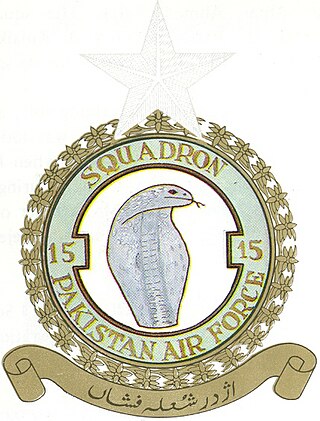
The No. 15 Squadron, nicknamed Cobras, is a tactical attack squadron of the Pakistan Air Force (PAF). The Squadron is currently based at PAF Base Minhas in Kamra, Punjab, Pakistan and equipped with Chengdu J-10C multirole fighter jets. The Squadron also carries the honour of achieving the first kill for the PAF.
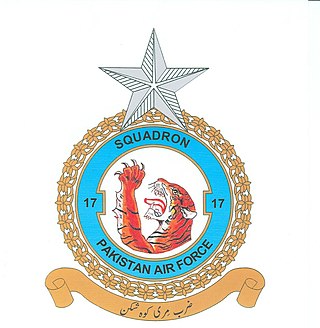
The No. 17 Squadron nicknamed Tigers, is an air superiority squadron of the Pakistan Air Force's Northern Air Command. It is currently deployed at Peshawar Air Base and operates the Chengdu F-7PG aircraft.

Yunus HussainSJ was a Pakistan Air Force officer who shot down 2 Hawker Hunter's of the IAF, one being flown by F/O AR Gandhi over Halwara. Shortly after, Yunus was shot down in the same area by F/L Vinod Neb after making a mistake by turning to the left into Nebs range. He is considered one of the greatest war heroes of Pakistan during the Indo-Pakistani War of 1965. Yunus received the green endorsement award twice from C-in-C of the PAF Asghar Khan. This recognition was in honor of his passion for flying, which led him to achieve the fastest 500 and then 1000 flying hours in the PAF.















